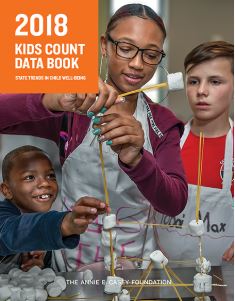Annie E. Casey: 2018 Kids Count Data Book
Where are living conditions best for children in the United States, and where are they the most challenging? The annual KIDS COUNT Data Book from the Annie E. Casey Foundation delves into this question each year, capturing the overall picture of a child’s well-being, both across the entire nation and state by state.
Using U.S. Census data, as well as information from a nationwide network of KIDS COUNT organizations, the Data Book presents conditions in the 50 states and aggregates indicators to create an overall score and rank for each state. In the 2018 edition, New Hampshire tops the list for overall wellbeing, while New Mexico ranks last.
The Data Book goes well beyond lists, however. It allows users to view data and trends in four areas that capture what children need in order to thrive: Economic Well-Being, Education, Health, and Family and Community. Each of the domains includes four indicators of child well-being, such as housing cost burden, reading proficiency, or living in high-poverty areas. The 2018 report compares the most recent results for each indicator to the earlier results to show trends. In this year’s Data Book, the Economic Well-Being indicators are all showing improvement, but results in the other areas are more mixed. The authors include background discussion for each indicator, explaining why it’s important and what the data is telling us. In the web-based, interactive KIDS COUNT Data Center, users can see state-by-state information on the indicators or use the KIDS COUNT Index to view fine-tuned data at the city or congressional district level.
As the 2020 Census count approaches, this year’s Data Book includes a foreword that precautions the undercounting of young children, typically children under the age of 5 and from low-income or minority families. The problem of undercounting children in the US Census has grown since 1980, with the gap trending larger. Why does undercounting even matter? The federal government relies on census data to determine the level of need for government programs that provide low-income families with assistance for housing, food, medical care, early childhood education and other critical needs. Without an accurate count of the numbers of people in need, these programs are virtually guaranteed to be underfunded. The Data Book discussion includes concrete steps you can take to help ensure a more complete and accurate count in 2020.
